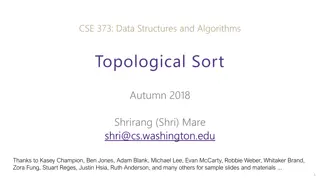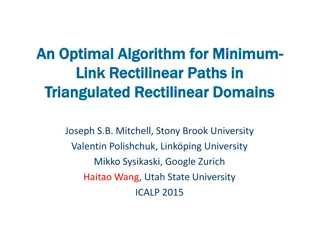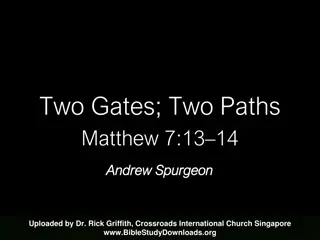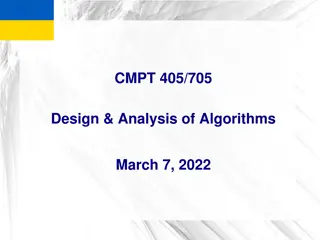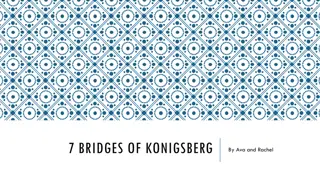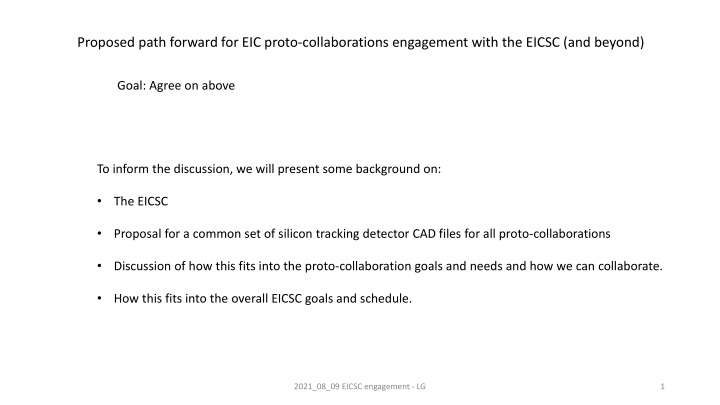
Development of Common Silicon Tracking Detector CAD Files for EIC Proto-Collaborations
Explore the initiative by the EICSC for a unified set of silicon tracking detector CAD files across proto-collaborations within the EIC project. Learn about the history, goals, and collaboration opportunities of this endeavor towards creating a comprehensive tracking detector solution for EIC implementation.
Uploaded on | 2 Views
Download Presentation

Please find below an Image/Link to download the presentation.
The content on the website is provided AS IS for your information and personal use only. It may not be sold, licensed, or shared on other websites without obtaining consent from the author. If you encounter any issues during the download, it is possible that the publisher has removed the file from their server.
You are allowed to download the files provided on this website for personal or commercial use, subject to the condition that they are used lawfully. All files are the property of their respective owners.
The content on the website is provided AS IS for your information and personal use only. It may not be sold, licensed, or shared on other websites without obtaining consent from the author.
E N D
Presentation Transcript
Proposed path forward for EIC proto-collaborations engagement with the EICSC (and beyond) Goal: Agree on above To inform the discussion, we will present some background on: The EICSC Proposal for a common set of silicon tracking detector CAD files for all proto-collaborations Discussion of how this fits into the proto-collaboration goals and needs and how we can collaborate. How this fits into the overall EICSC goals and schedule. 2021_08_09 EICSC engagement - LG 1
History and goals The idea of adapting MAPS silicon sensors that were under development at CERN for the ALICE ITS-3 detector for use in an EIC tracking detector was first presented in December 2019 https://indico.jlab.org/event/348/sessions/1224/attachments/4665/5789/open-mic.pdf This idea formed the basis of the eRD25 project (Birmingham, LBNL, RAL) whose aim was to lay the groundwork for the development of an EIC vertex and tracking detector based on this technology: https://wiki.bnl.gov/conferences/images/1/1c/ERD25-proposal-Jul20.pdf One fundamental aspect of the proposal was the establishment of a much broader EICSC to grow the required base of expertise to develop a full inner tracking solution for EIC detectors based on a new 65 nm MAPS technology (sensors, mechanics, services, cooling, readout, etc.). This was the basis of the EICSC proposal to BNL for the Expression of Interest, that was signed by LBNL, BNL, CCNU, JLAB, ORNL, and seven UK groups: https://indico.bnl.gov/event/8552/contributions/43219/. This EOI formalized the start of the EIC SC. 2021_08_09 EICSC engagement - LG 2
History and goals The EICSC is a collection of institutions that work towards the common goal of developing a complete silicon tracking detector solution based on ITS-3 technology for use at EIC. We have welcomed anyone with interest in our goals to join from the start and continue to do so. What we can produce is limited by our membership resources, and at the moment, EICSC institutions are dedicating their own resources to advance this effort. The EICSC is not tied to a specific detector proposal/proto-collaboration, but open to institutes from all proto- collaborations interested to work on the proposed detector solution for their specific EIC detector implementation, as stated here https://wiki.bnl.gov/conferences/images/3/36/ERD25-Mar20-final.pdf. It has always been our goal to provide a forum and structure for those working on silicon for EIC and we will of course work on all aspects that are useful to the (proto-) collaborations and consistent with our focus. This format is only natural as all proto-collaborations have adopted the technology proposed by the EICSC and work on the realisation of the detector can only progress if the EICSC has enough resources. What we generate should be useful to all. This approach maximises the successful delivery of the technology with the lowest cost to the project. We encourage all proto-collaborations to engage actively with the EICSC effort to reach their goal of realising a silicon tracker for the EIC. 2021_08_09 EICSC engagement - LG 3
Path forward for development of silicon tracking detector for EIC: Stage 1 Meeting held on 2021_07_03 with Leo Greiner, Jim Fast, Walter Sondheim, Ernst Sichtermann, Laura Gonella with discussion of how to move forward with agreement on a two-stage plan. Stage 1. Generation of simple silicon tracking detector simulation model. This would be the all-silicon design with the parameters shown in the YR and documented (insert link). It will contain: the active silicon areas proper sizes of the detector elements (stave thickness, discs, etc. to map out the needed space) elementary mechanics that put mass of the proper types in the proper places to provide internal supports and interface to global supports. Elementary service loads based on the parameterization already done and presented. This will be modified to reflect at least DC-DC converters for power and more in subsequent versions. This model would be released to the proto-collaborations and will form the basis of a common silicon tracking detector baseline based on the all-silicon concept. This should allow more realistic simulations to begin as quickly as possible. Proto-collaborations that wish to modify the models to fit their particular detector design ideas would have a good starting point and they should continue consultation on those within the EICSC. 2021_08_09 EICSC engagement - LG 4
Elements of the vertexing layers 2 x 40um silicon layers at nominal all-silicon radii structural shell (300 um thick) and carbon foam (5%?). services of appropriate sizes exiting from both ends of vertexing layers and routed out. Provision in the full design for air cooling needs (ducts and exit from the carbon support shell). Mechanics for positioning the vertexing layer assemblies into the full silicon tracking detector. 2021_08_09 EICSC engagement - LG 5
Elements of the barrel layers Composite flex PCB and cooling plate silicon 50 um thick silicon active areas Flex PCB and composite cooling plate material definitions to give nominal X/X0. Layers at nominal positions defined for all-silicon detector. Layer tilt and overlap to be defined and then tested by simulation (start with 1mm overlap and 15 degree tilt? TBD). services of appropriate sizes exiting from one end (hadron) of stave layers and routed out. Mechanics for positioning the set of barrel layer assemblies into the full silicon tracking detector. Mechanical space holder for support truss 2021_08_09 EICSC engagement - LG 6
Elements of the discs component % X/X0 plate 0.15 Start with single sided plate option (see next slide for dimensions, X/X0. Keep nominal all-silicon detector active areas and positions services of appropriate sizes exiting from the outer circumference of the disc layers and routed out. Mechanics for positioning the set of layer assemblies into the full silicon tracking detector. Si 0.05 FPC 0.13 Water + tube 0.03 Glue + other 0.04 total ~0.4% Tiling comes later 2021_08_09 EICSC engagement - LG 7
Cross section of half disc plate (for all plate models) under each sensor 10% carbon foam (4 mm) 0.15% X/X0 (0.11% carbon, 0.04% glue) Carbon fiber face sheet (200 um) Silicon (50 um) = 0.05% X/X0 / layer Al conductor FPC (60 um Al + 25 um kapton) = 0.13% (Al thickness reduced assuming ITS-3 like power dissipation) water + kapton cooling tube (2mm) = 0.03% (assume 1 cooling tube per sensor due to reduced dissipation 2021_08_09 EICSC engagement - LG 8
Path forward for development of silicon tracking detector for EIC: Stage 2 Stage 2. After the baseline all-silicon model is delivered, we would then continue work on the design and detailing of our CAD models for use in the project full detector model concept. This would include: Work on the effects of reticle size and implications for vertex layer spacing. Design of discs and tiling of reticles gaps. Detailing of mechanical supports and design ideas for inserting vertexing layers as clamshell (still need to figure out how to keep disc edges away from hot beam pipe). Interfacing to global mechanical supports. Detailing and revising services routing and quantities. Tracking support shells and how to integrate the packages. Meeting the constraints imposed by overall detector needs (bakeout, inserting full detector, etc.) The idea is that as we refine the design, we would make more detailed models that would then be passed to the proto-collaboration simulation efforts. We would also take feedback from the simulations and identify areas where we need to modify the baseline designs to improve the design to meet physics needs. This will be an ongoing feedback loop that will continue through the development of the overall detector design tailing off after the TDR and CD-3. 2021_08_09 EICSC engagement - LG 9
Discussion During Stage 2, as the models reach a moderate level of maturity and we have some better understanding of the form of the mechanics and services, we will begin work on the generation of costing and schedule for the all-silicon model. This can be the basis for cost estimates for all the proposed configurations. How well does this proposal meet the needs of the proto-collaborations? How can the proto-collaborations help in this effort? Currently we have people from the proto-collaborations helping in the EICSC efforts. As we move into full detector collaboration(s) we hope and expect that the effort will continue and focus on the proposed detector layout(s). Again, all are welcome, and we have a large amount of development to produce a viable silicon tracking detector design. The work spans many disciplines. 2021_08_09 EICSC engagement - LG 10
Additional upcoming EICSC tasks Technical tasks are best described in EICSC meeting of May 17, 2021 https://indico.bnl.gov/event/11683/contributions/49634/attac hments/34496/55944/2021_05_06_EICSC_WP_proposal.pptx However tasks like the ones currently under discussion are needed by the community and are also important and time critical and we engage with them as the need arises. 2021_08_09 EICSC engagement - LG 11
Plans (strongly tied to ITS-3 schedule) 2021 Testing and characterization of MLR1 Sensor design for MLR2 or ER R&D into powering, stave/disc construction, cooling, overall infrastructure MLR2 submission Thinning, bending and sensor interconnection 2022 - Testing and characterization of MLR2 Sensor design for ER R&D + prototyping into powering, stave/disc construction, cooling, overall infrastructure ER submission 2023 - Testing and characterization of ITS3 ER and assessment of yield Assessment and planning for EIC sensor fork of ITS3 design Fork off sensor design and work on EIC variant for staves and discs (may move to next year depending on results) Detailed prototyping into powering, stave/disc construction, cooling, overall infrastructure ER submission for EIC variant sensor for staves and discs (may move to next year depending on results) Investigation of adaptation of ITS3 design for use in EIC inner layers (different radii, # layers, services from both ends to meet length requirements, etc. 2024 Testing and characterization of EIC ER and assessment of yield Si design for EIC ER2 Detailed prototyping into powering, stave/disc construction, cooling, overall infrastructure using EIC ER1 prototypes. ER2 submission for EIC variant sensor for staves and discs adaptation of ITS3 design for use in EIC inner layers and integration of design into ER2 if necessary. We are developing two detector concepts: 1. ITS3 like for the vertexing layers. 2. EIC variant for the staves and discs. We will need to develop the capabilities to bring both detector concepts and the associated infrastructure to completion. 2021_05_06_ EICSC_WP_proposal - LG 12
Expanded task list for 2021 (applies to following years as well) These tasks complement and are in addition to robust participation in the ITS3 work packages to prepare for the EIC vertexing layers design. 2021 Testing and characterization of MLR1 EICSC WP3 design of testing system that extends into the testing of the next submissions. Beam testing, Latch-up testing, SEU testing, radiation tolerance testing (kRAD, NIEL), firmware, software, mechanical carriers, alignment stations, analysis, etc. This work is starting in ITS3, we can/should join this effort. Sensor design for MLR2 or ER EICSC WP2 Inclusion of other silicon design sites into the design process (in progress), Assessment of the testing results and incorporation into the new designs, significant digital design (in pixel logic, readout structures and architecture), design for stitching, significantly more complex structures and pixel layout studies, design for yield, etc. R&D into powering, stave/disc construction, cooling, overall infrastructure EICSC WP5 Take up DC-DC converter and serial powering R&D, studies of stave and disc design, cooling studies (air for inner layers, liquid? For outer layers and discs), investigation of on detector data multiplexing and implications for single point failure and redundancy studies, initial studies for carbon fiber designs for overall mechanical support structures, services routing studies, radiation length minimization, etc. MLR2 submission EICSC WP2 Detailed silicon design as per sensor design section, layout and DRC, integration into MLR, etc. Thinning Bending and Interconnection EICSC WP3 Thinning/bending studies, test beams and assessment, interconnection designs 2021_05_06_ EICSC_WP_proposal - LG 13









